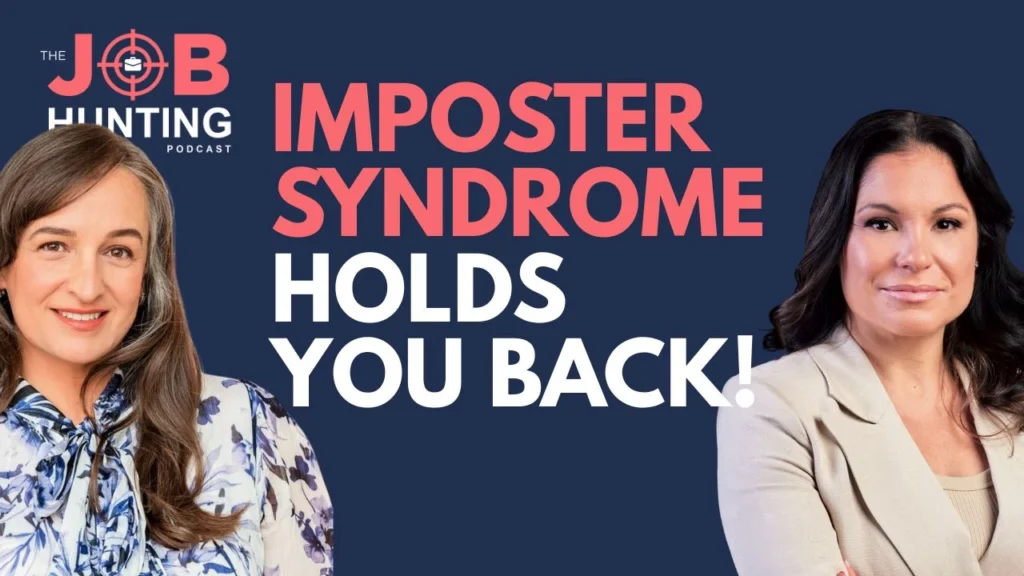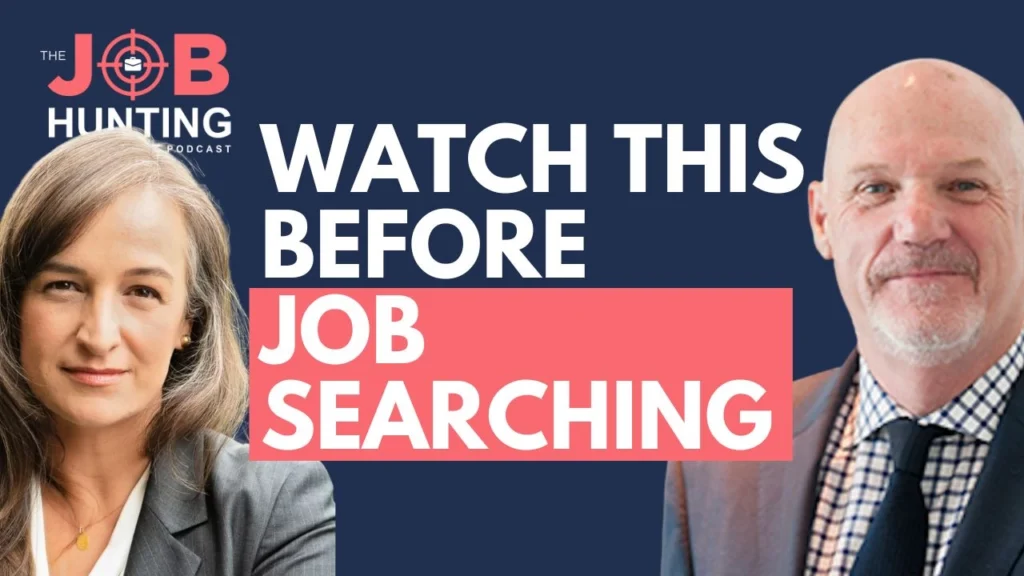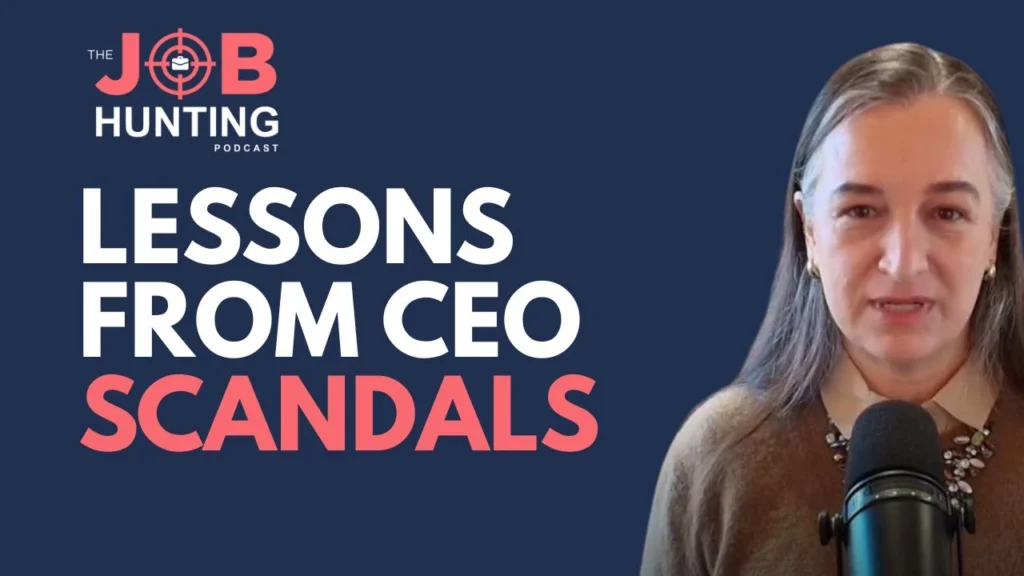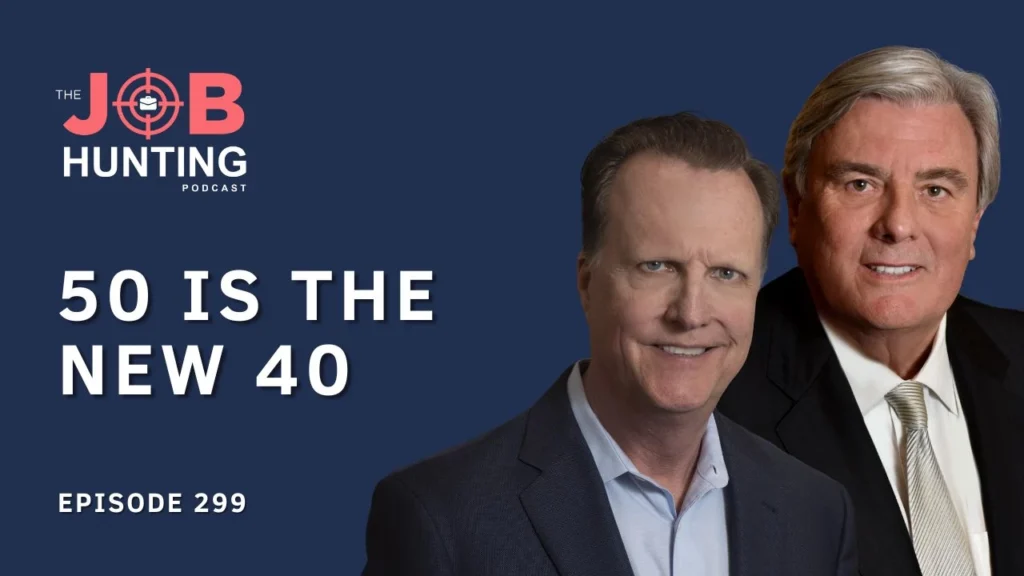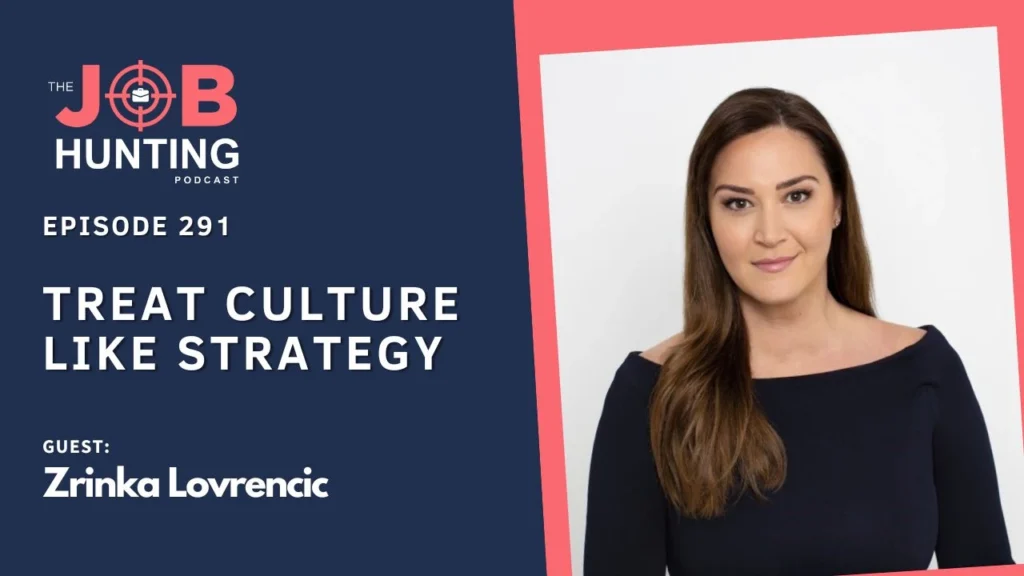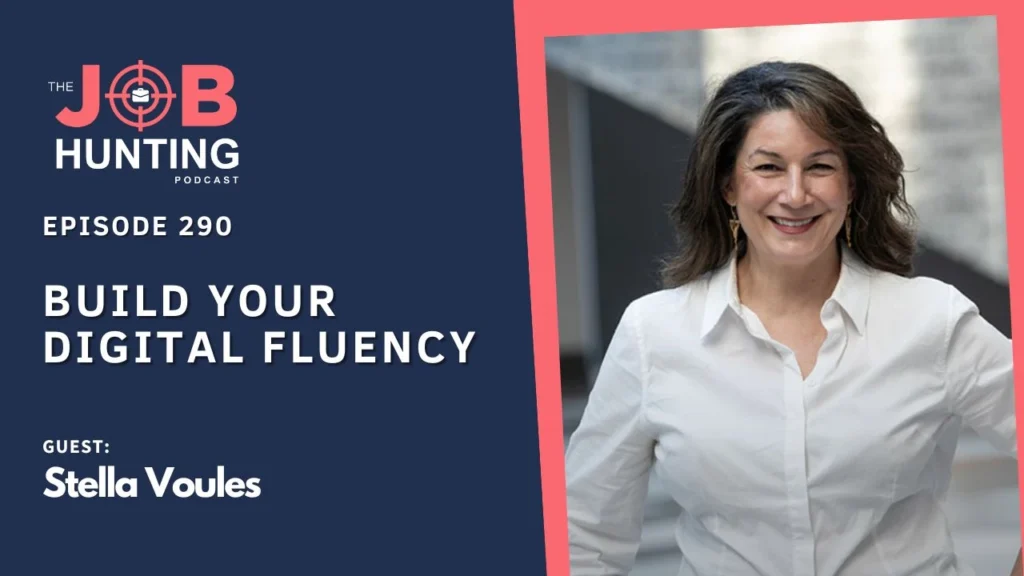The Career Advice You Didn’t Get
Episode 49 - Leadership and Career Success: The Career Advice You Probably Didn’t Get, with Susan Colantuono
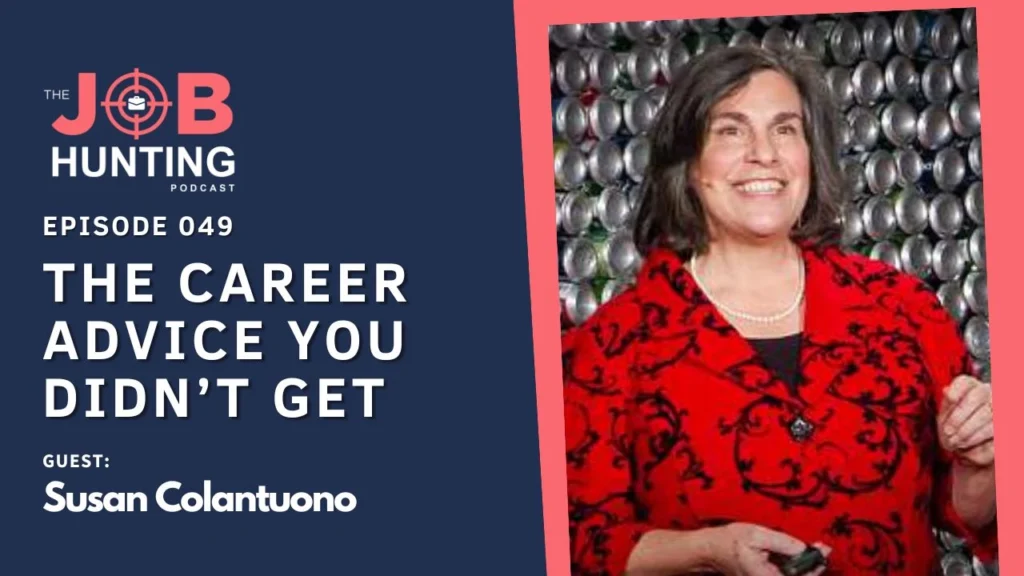
This episode is dedicated to a better understanding of the relationship between leadership skills and career progression. Susan and I go through many exciting discussions about leadership and its link to career development and advancement. This synergy and connection are crucial for my ambitious clients: those who want to look for a new job opportunity and want that opportunity to stretch their skills and experience further.
I was so grateful that, in preparation for the recording of this episode, I had the opportunity to read her book, No Ceiling, No Walls, which I now recommend to my clients as well.
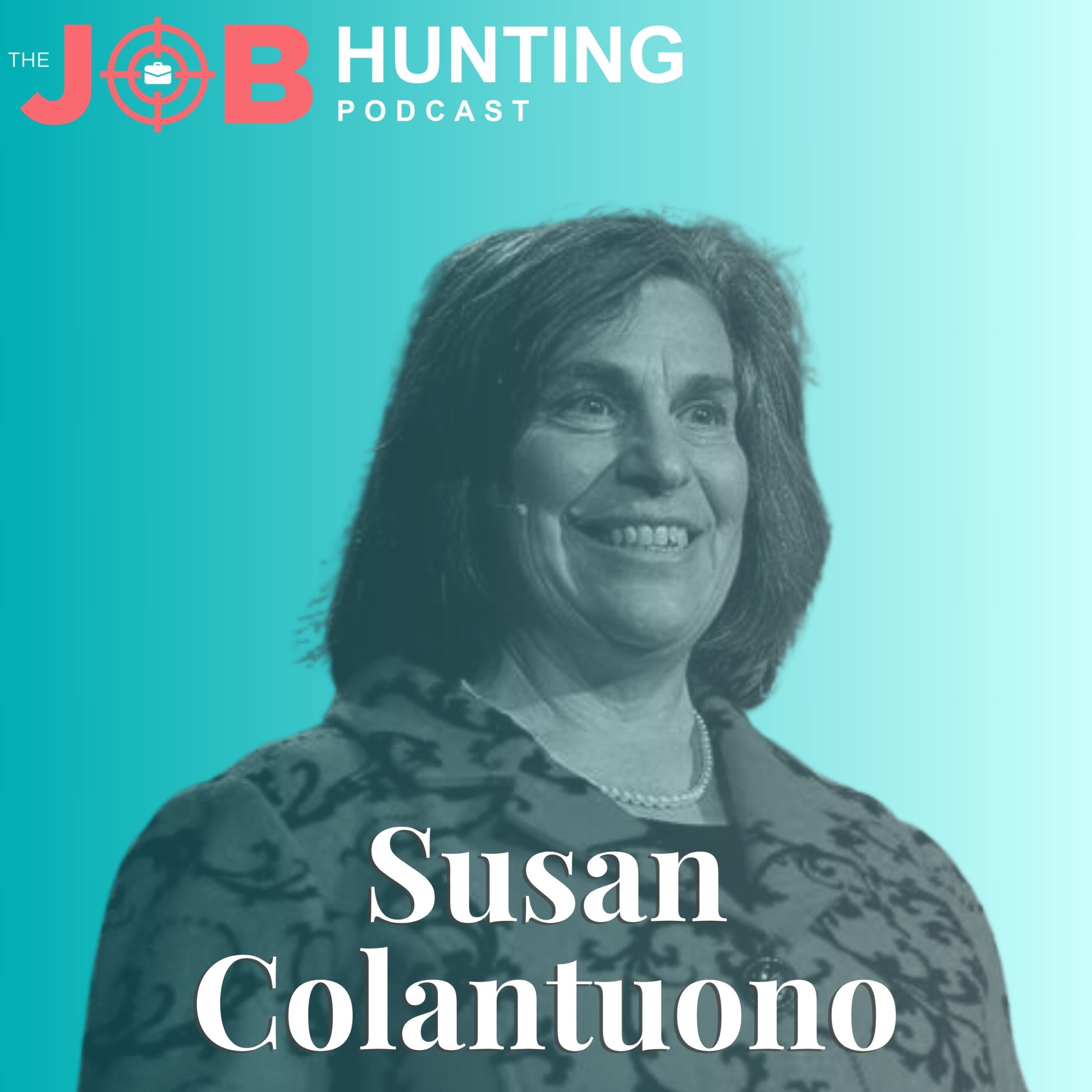
About Our Guest, Susan Colantuono

About the Host, Renata Bernarde
Hello, I’m Renata Bernarde, the Host of The Job Hunting Podcast. I’m also an executive coach, job hunting expert, and career strategist. I teach professionals (corporate, non-profit, and public) the steps and frameworks to help them find great jobs, change, and advance their careers with confidence and less stress.
If you are an ambitious professional who is keen to develop a robust career plan, if you are looking to find your next job or promotion, or if you want to keep a finger on the pulse of the job market so that when you are ready, and an opportunity arises, you can hit the ground running, then this podcast is for you.
Resources Mentioned in This Episode
Timestamps to Guide Your Listening
-
09:50 – Susan’s career story
-
16:00 – How she chose her preferred area of expertise
-
17:59 – The idea behind her famous TEDTalk: The ‘missing 33%’
-
21:51 – Feedbacks and pushbacks
-
25:23 – What has changed since her book No Ceiling, No Walls was written 10 years.
-
30:19 – Superwomen and infrastructure
-
34:09 – Tools and resources to move forward in your career
-
37:32 – Be careful what you’re good at
-
40:27 – Employee perspective and manager perspective
-
42:26 – Hiring you is an investment
-
46:26 – Participant’s question: Promotion in the higher-education/public sector
-
50:41 – Participant’s question: Insights on diversity and inclusion
Transcript
Renata: Thank you to everyone attending live today, and to those who have joined the recording. It’s quite unique for me to do this, and I’m very excited to have so many great people here this morning. Joining us is Susan Colantuono, currently the co-host of A Career That Soars! Susan is the retired CEO and founder of Leading Women, a cutting-edge provider of leadership development solutions for women in organizations. She also founded the Women’s Institute for Leadership at Bryant University and is the author of No Ceilings, No Walls: What Women Haven’t Been Told About Leadership—from Career Start to the Corporate Boardroom and Make the Most of Mentoring: Capitalize on Mentoring and Take Your Career to the Next Level. Susan has been a pioneer in delivering leadership development, diversity, and inclusion solutions to organizations across various industries and sectors.
Renata: Her expertise has benefited organizations including the CIA, Corn Products, Exxon, Kodak, Marriott, Pfizer, and many others. She has advised leaders in organizations like Engine, MetLife, US Bureau of Land Management, New York Life, Fidelity, and so on. Susan has published numerous articles and authored several books, as I mentioned earlier. I personally discovered Susan through her TED Talk about the “missing 33%,” which was a few years ago. Since then, I’ve recommended that TED Talk to many of my clients, some of whom are here today and can attest to its impact. A few months ago, I interviewed her collaborator from A Career That Soars!, Michelle Redfern. I’ll include a link to that episode in the show notes for today.
Renata: When I mentioned Susan’s TED Talk to my clients, Susan noticed that I had mentioned her on the podcast, reached out, and I immediately jumped at the opportunity to invite her to be a guest. I am so delighted she accepted. We had quite a bit of trouble finding a time that suited both of us. She’s laughing because, as someone with family all over the world, you would think I’d know how to manage different time zones, but no, not really. I’m glad we finally found a time that suits both her on the East Coast of the US and us here in Melbourne. Welcome, Susan, to The Job Hunting Podcast.
Susan: Thank you, Renata. It’s such an honor to be here, especially given what it took to set this up, but particularly because I love the concrete, actionable focus you bring to your podcasts. They’re just spot-on. You have incredibly talented and knowledgeable guests, add your own perspectives, and keep the focus on, “Okay, so how can this help me get my next job or move into my next promotion?” I commend you on the quality of your podcast, and it really is an honor to be here today.
Renata: Thank you, Susan. I actually wrote about this yesterday. Initially, I was concerned that the purpose of The Job Hunting Podcast might be misunderstood. However, our followership is growing. My philosophy is that you should always be job hunting in the sense that you should always be open to opportunities. And now, I’m beginning to introduce myself not just as a job-hunting expert, but more as a visibility coach. You know, you have to be visible, you have to be present. I’m starting to expand on the idea that jobs will actually come to you if you position yourself properly, so you won’t always have to be actively hunting, right? The opportunities will be available to you. The podcast now reaches over 50 countries, which is really lovely. Just yesterday evening, I spoke with a Mongolian student based here in Sydney, and I’ll be speaking to a group of Mongolian students in Sydney in a couple of weeks. She mentioned that she doesn’t usually fit our typical senior target market. She had been postponing her job search due to a lack of confidence. But after binge-watching all of your podcasts, she found a job.
Susan: Fabulous. Oh my goodness.
Renata: There are 44 episodes. So, you know, she really did dive deep.
Susan: Wow, good for her. I have a funny story about visibility from my early career stages, which really reinforces what you’re saying. When I was just starting out, I was one of three women who, with the blessing of the CEO and in collaboration with the internal training department, launched one of the first women’s initiatives in the United States. I just did my real work and also pursued this initiative because I cared about it. About a year after the initiative was up and running, I received a phone call. It was Wendy Susko on the line—the only female attorney in the company and possibly in the insurance industry in Hartford at the time. She said to me, “Susan, there’s a job opening in the training department, and I think you should apply for it.” This really illustrates how voluntary activities can build your brand unexpectedly. She reached out to me, and I consider her one of my first mentors, even though our only interaction was that one phone call. So, visibility really does matter, and opportunities can come, not always, but often.
Renata: And in your book, you mention that leadership can be learned, and I say, visibility can be learned too.
Susan: Yes, I agree.
Renata: Let’s dive into your career. I really want to know how you became this remarkable leadership coach with a focus on women. When did you decide this was your path—would you say it was a calling, or was it more of an organic progression?
Susan: It was a bit of both. You mentioned I’m retired, so I’m from an earlier era.
Renata: Well, it’s in your bio.
Susan: And, I grew up in the fifties in the United States. At that time, the roles for girls and women were quite constrained, and I railed against that from a sense of justice—it just wasn’t right to me. That was always a passion of mine. I got involved in the women’s movement early on. Then, when I entered corporate America, I launched a women’s initiative, which marked the beginning of my career journey, which I think of in three stages.
Susan: The first stage was as an employee at a privately held company, where I launched the women’s initiative. I consider this time foundational. I learned you have a brand, so you must be careful with your actions. I learned from the CEO never to bring up problems without proposing solutions. My first boss taught me the importance of building and engaging teams in projects.
Susan: I also had one horrible boss from whom I learned what not to do, like avoiding micromanagement and refraining from giving sexist or racist feedback. This period was formative—I gained insights into company politics, organizational structures, and their rationale. After nine years, I left the insurance company and became a solopreneur, a consultant. This period involved a lot of work in leadership development, diversity and inclusion, and especially managing complex changes. My real work before moving to the training department involved implementing a computer system, so I was a pioneer in change management.
Susan: As a solopreneur, I observed many managers and executives—some were fantastic, and others, not so much. An important lesson was learning to meet the client where they were. They might say they needed XYZ, and while I saw they needed ABC, it wasn’t smart to try to push ABC on them. This principle applies to managing and developing teams as well. During this time, I worked with boutique consulting firms across a wide range of industries and government organizations, which was enlightening and expanded my understanding of what works organization-wide.
Susan: Toward the end of this period, I began conceiving the idea for Leading Women. I was at a point in my career where I knew I wasn’t loving what I was doing. I took the hedgehog concept from Jim Collins’ book Good to Great. If you’re unfamiliar, it’s about finding the overlap between what a company is passionate about, its profit formula, and what it can be the best in the world at. I modified this for individuals. At a career crossroads, I sat down and asked myself: What am I passionate about? What am I really good at? What could I get paid to do? The overlap of these three circles was Leading Women. I realized I could develop a consulting firm focused on helping organizations move women into senior leadership positions. So, that’s exactly what I did.
Renata: Oh, I have Good to Great right here.
Susan: Oh, good. Yes, the hedgehog concept was one of the differentiating factors in companies that transitioned from good to great performance and sustained it over time. It’s about finding the overlap between what the company is passionate about, its profit formula, and what it could be the best in the world at. I thought this concept could be adapted for individuals. At a career crossroads, I literally sat down and asked myself: What am I passionate about? What am I really good at? What could I get paid to do? The overlap of these three circles was leading women. I realized I could develop a consulting firm focused on helping organizations elevate women to senior leadership positions. So, that’s exactly what I did.
Renata: Excellent. And, um, were you going to say more?
Susan: Yes, I have more to add. In a recent conversation, it came up that many leadership theories suggest that culture eats strategy. If you have a bad culture, you can’t execute a strategy effectively, but having a good culture without a strategy also means failure. Strategy really matters, as I learned, and I can explain why later because it relates to another question we wanted to discuss.
Renata: No, I wanted to ask you specifically about your work with women. When I spoke to Michelle, she works with senior executives who manage women. Did you decide to focus primarily on working with women themselves to help elevate them to senior roles? Was that your preferred area of expertise?
Susan: When I started Leading Women, it was initially a business-to-consumer organization, providing services directly to women. However, a few years into it, I realized that this strategy wasn’t viable for building a sustainable business. We then shifted to a business-to-business model. It’s not enough to invest in women without also working with their managers and addressing the culture of the organization. Leading Women still encompasses all of that, even though I’m retired. But now, with A Career That Soars!, it’s back to my first love—focusing on woman-to-woman support and building a network.
Renata: That’s why I send your TED Talk to my clients, both men and women. Just yesterday, which was a coaching day for me, I had a series of sessions where I had to correct clients—again, both men and women—on how they position their business acumen versus their soft skills. I refer to them as ‘soft skills,’ not because I believe they are less important—I don’t agree with that terminology—but because it’s commonly used. We had to revise the order of bullet points and phrases in their pitches. Can you explain to our listeners what the missing 33% is, in case they’re not familiar with it? I think it would be enlightening. I’ll also add a link to that TED Talk in the episode show notes. But when did you have your eureka moment about it? When did you realize, ‘Oh, people aren’t noticing this. I should talk about it’?
Susan: Yes, kind of. At the end of my time as a solopreneur consultant, I was assessing what I wanted to do next. I began working with a couple of organizations as a subcontractor, delivering leadership development for women. What I observed was essentially generic leadership development with an added discussion about work-life balance. I questioned, “If generic leadership development is what it takes to get women ahead, why aren’t more women ahead?” It had been a generation—20 years—and still not enough progress.
Susan: Concurrently, a Businessweek article in 2000 titled ‘As Leaders, Women Rule: New Studies Find That Female Managers Outshine Their Male Counterparts on Almost Every Measure’ caught my attention. I read the article, then delved into the source studies it summarized. This research phase coincided with my own efforts to define leadership in a way that was simple, clear, and actionable. I couldn’t find a definition that fit, so I created one: Leadership is using the greatness in you to achieve and sustain extraordinary outcomes by engaging the greatness in others.
Susan: I categorized the factors from the studies where women were rated as outperforming men, and vice versa, particularly in areas where the raters were managers, into this three-part definition. The findings consistently showed that in terms of using individual attributes like intelligence, creativity, reliability, and diligence—women and men were rated roughly equal. In engaging the greatness in others, like team development and communication skills, women were rated higher than men. However, in areas like business, strategic, and financial acumen—critical for achieving and sustaining extraordinary outcomes—men were rated higher than women. This discrepancy is what I call the missing 33%. It’s not that women don’t possess these skills; it’s that they’re perceived not to have them. We need to demonstrate these capabilities more clearly, and yes, some of us need to develop them further. That’s the essence of what I discuss in my TED Talk.
Renata: When you brought this to women’s attention, what kind of feedback did you receive? Now, people are aware of it because you talk about it often, but initially, was there any pushback? I experience some, so I’m curious if you do too.
Susan: Most women were like, “Holy cow, you’re absolutely right. Nobody’s ever made this clear to me. I never realized how important it was.” Many thought leadership was all about engaging their teams, which they excelled at, yet couldn’t understand why they weren’t advancing. However, there were some who misunderstood my point, thinking I was suggesting that women can’t possess business, strategic, and financial acumen. I clarified that’s not what I’m saying—we have Fortune 500 women CEOs who clearly have these skills. But that’s the kind of pushback I tend to receive.
Renata: The pushback I often receive is that individuals perceive themselves as lacking certain strengths. As a strengths-based career coach, I encourage them to focus on their strengths. However, they might say, “Oh, but that’s not my strength. I’ve moved away from that.” For example, if they have a background in accounting or finance from their undergraduate studies but now want to pursue something else, it’s still part of their executive DNA and highly valued by hiring managers.
Susan: Absolutely, yes. And if you want to build a career within an organization, you must have and be able to demonstrate your business, strategic, and financial acumen. The HR executive who becomes a Chief HR Officer, for instance. Why? Because the CEO trusts them to look out for the business and make decisions based on the financial performance of the company. The same goes for the Chief Marketing Officer. No matter your role, if you want to move up beyond middle management, that acumen is the differentiator. Even in the legal department, I was asked to speak at a conference for women corporate attorneys interested in becoming the Chief Legal Officer or Corporate Counsel. In the US, Corporate Counsels are very active in the boardroom, making it an excellent entry point to board positions.
Renata: They’re also called Company Secretaries in Australia.
Susan: Yes, Company Secretaries. So, I interviewed CEOs and General Counsels and asked what they look for in candidates for General Counsel, Corporate Counsel, or Company Secretary positions. Almost all of them emphasized the need for someone who can advance the business in their decision-making. We don’t want legal advisors who find all the reasons why something can’t be done; we want people who can help the business move forward. So, even if it’s not your strength, you need this acumen. Otherwise, you will get stuck.
Renata: Exactly. And speaking of progressing in your career, Susan, I usually read non-fiction books quite quickly unless I really love the book. Then, it takes me forever to finish because I keep making notes, opening client files to add something, and so on. Your book had a list of beliefs on the first page about why one should read it, quickly revealing that these beliefs could be barriers to career progression. The book was written over a decade ago. Do you think there are any differences today, especially with the impact of COVID-19? What I’ve been experiencing in 2020 with people coming to me is a complete sense of uncertainty and paralysis by analysis. I would add that to your list. But I’d like to hear your views as well. Have you thought of other items that could be added to the list, or are there aspects that remain very much real and have even been reinforced by our current situation?
Susan: Right, some of the initial points in my book address common misconceptions. For instance, the book is for you if you believe that the playing field has been leveled and women are as likely to advance as men. Unfortunately, that hasn’t changed much. Yes, it’s being leveled, but there are still plenty of potholes and roadblocks across the field. The book is also for you if you’ve taken leadership courses in the past and expect them to help you climb the corporate ladder. Some companies have become smarter about incorporating business, strategic, and financial acumen into their leadership development courses, so there’s been some progress there. Another point is for those who can’t read a financial report and don’t think it matters—you absolutely need to understand the key aspects of financial reports, but more importantly, the story they tell about the strategic decisions companies are making.
Susan: Most of what I wrote about is still a concern today. Additionally, when I wrote the book, many organizations were completely unaware of the role of gender dynamics or what some call unconscious bias—I don’t like that term because a lot of bias is absolutely conscious. I prefer to discuss gender dynamics in terms of the impact of people’s beliefs about women and men, which includes beliefs about what leadership looks like. For example, if someone believes leadership is authoritarian and that it’s weak to solicit opinions, this can negatively impact women’s career progression, as many women excel in engaging others. So, back then, many organizations were oblivious to how gender dynamics affected talent decisions, but before COVID, there was more effort put into helping managers understand these dynamics.
Renata: It’s interesting, especially in politics, to observe international leaders and countries with female heads of state. There’s now a discourse on how well these countries are performing. We don’t have a large sample size, but it’s encouraging to see their success. However, in contrast, as of 2020 in Australia, we’ve never had as many unemployed women as we have today.
Susan: That was a point I was also thinking about, as the pandemic has had a disproportionately negative impact on women.
Renata: Absolutely, and it relates to the types of industries and sectors where women predominantly work, as well as the casual nature of their employment. One thing that surprised me when I arrived in Australia was the lack of childcare funding. I expected more support for that. Because of this and other issues, even well-educated women with corporate careers often work part-time when they have children, sometimes stepping back for a decade before re-entering the workforce full-time. Additionally, middle-class Australians tend to have more children.
Susan: Really? More than two?
Renata: Yes, two and a half, on average. Financially comfortable families often have three or four children. Many of my friends have four kids. And if you have four kids during a pandemic, and they’re all home, each in different grades doing virtual learning—it’s a huge challenge.
Susan: Oh, managing home and different grades with virtual learning—Oh my God.
Renata: There’s this awesome tweet from someone connected to my friends on Twitter. She’s like a superwoman. She has four or five kids, and when one of them had to resign because of the pandemic, it wasn’t her. So she’s managing everything, which is incredible, especially with all four kids staying at home and studying—it’s driving everybody insane. All of these factors are considerations, and I think the response varies significantly from country to country. We were all in this together at the beginning of the pandemic, but now things are quite different depending on the country you’re in.
Susan: In the United States, traditionally during recessions, investments in infrastructure like roads, bridges, and school buildings have been the path out. However, women are vastly underrepresented in the jobs related to building infrastructure. But something Elizabeth Warren mentioned during the Democratic convention last week resonated with me. She said that caregiving—childcare, eldercare, and care for the disabled—is also infrastructure. I was really glad to hear her acknowledge that because, as you’ve mentioned, you can’t have a functioning economy if people aren’t able to work. And to work, you need support with childcare, elderly parents, and disabled family members.
Renata: Absolutely, and this brings us to how we perceive women and men’s leadership styles. We’ve touched on this earlier in the podcast, but I’d like to reinforce it for our listeners, many of whom are women. How can they access tools to be perceived as ready for promotion? Susan, what tools and resources would you recommend for moving forward in their careers?
Susan: Well, of course, I would recommend joining A Career That Soars! and reading No Ceiling, No Walls and Make the Most of Mentoring. They are very action-oriented resources. Not to toot my own horn, but they are effective. Women tell me that applying the content has positively impacted their careers. More generically, I would advise everyone to seize every opportunity to do two things: First, if you don’t yet have your business, strategic, and financial acumen—skills necessary to understand the totality of the business, where it’s headed, and your role in driving it forward—if you’re not able to interpret the story the financials are telling and how these influence decisions, especially now when all companies are conserving cash, then you need to develop those skills. Understand how strategy is set and tap into what’s happening in the external environment beyond just the immediate impact of COVID.
Susan: And if you have them, learn to speak the language of power. Renata, to your earlier point about what to lead with, if you’re building a resume or proposing an idea, leading with business impact is crucial, especially the higher you climb in an organization. It will be assumed that you’re good with people. So if you’re early in your career, yes, develop your interpersonal and team skills, but also focus on your business, strategic, and financial acumen. Learn how to build teams, hone effective one-on-one communication, and how to give constructive feedback. I want to take a moment here because I spoke to two people today who, if they were my employees, would need very direct feedback about their over-the-phone or Zoom communication skills. It’s challenging to convey this in virtual settings, so developing and demonstrating your business acumen and using the language of power by leading with your contributions to the business is essential. Does that address your question about concreteness?
Renata: Yes, that’s very helpful. Using the language of power and positioning yourself for opportunities is exactly what I was getting at. But it made me think of something else when you mentioned understanding that managing people could be the next step up. From one coach to another, it reminds me of something my dad used to say: “Be careful what you’re good at.”
Susan: Be careful what you’re good at, yes.
Renata: Yes, because it might prevent you from being promoted. If you become very proficient at a certain level of leadership, say as a great middle manager, and your skills and capabilities are perceived to be suited only for that level, it might hinder your promotion to the next level. You might be performing at the highest standards, but that doesn’t necessarily mean you’ll be promoted. And that’s one of the hardest conversations I have with clients who are eager for a promotion and don’t understand why they’re not considered. They perform well, meet all targets, and then, unfortunately, some start to underperform due to their frustration.
Susan: Exactly. I often tell people, “If you’re the only one who can do your job, you’ll always have the job you’re doing.” Develop your successor, which is a shorthand for what you’re saying. You can’t be seen as the only one who can do your job, or else you get stuck.
Renata: Yes, and it’s not just about succession planning. It’s also about the behaviors, traits, and skill set you’re developing as a professional. You need to be in a growth mindset, always ready to learn something new about leadership, to uncover your blind spots. In your book, there’s a sentence I noted and even emailed to a client. I can’t find it right now, but it goes something like, “The way the job looks from your perspective is not the same as it looks to the hiring manager.” Does that sound familiar?
Susan: Exactly, yes. It’s crucial to understand what the hiring manager expects and their perspective. I wanted to touch on something about early career transitions, but remind me to circle back to the hiring manager’s perspective and strategy. One of the pitfalls in early transitions from career start to the first supervisory or management positions is the temptation to continue doing the technical work. The blind spot, or dark spot as you call it, is not realizing that the job now is to enable your team to do the technical work. Developing them is your new leadership responsibility.
Susan: Leadership means not just continuing with the tasks that got you into your new role but embracing the new responsibilities. A common issue I’ve seen over the years is women telling me their boss says they’re not strategic, even though they believe they are. They insist, ‘I am strategic. I see the big picture.’ I suggest asking their boss, ‘What does being strategic look like from your perspective?’ instead of defensively asserting their own view. It’s important to understand that their perspective might differ greatly from where their manager is standing.
Renata: Working with people who are job hunting, especially during frictional unemployment—which is the brief period between jobs—means they’re undergoing a lot of learning and experiencing many new things in a short span. It’s almost like being a consultant, as an executive applying for jobs involves speaking to several stakeholders involved in the hiring process. The frustration of not securing a job can be significant. I often use tennis as an analogy with my clients. If we don’t win one tournament, we prepare for the next. If my clients don’t like tennis, they might struggle because that’s how I frame it: we keep training and competing. But the underlying question often is, ‘Why is this taking so long? Why am I meeting so many different people?’
Renata: It’s essential to remember that hiring is a significant investment for a company. For example, if they plan to keep you for four years at a salary of $250K per year, or three years at $150K per year, that’s a substantial financial commitment. Once candidates understand this, the conversation shifts to more of a peer-to-peer interaction and becomes more strategic. This strategic acumen is crucial for a candidate, especially external ones applying for jobs. While you may not have access to all financial details and it might not be your personal strength, being able to discuss strategy effectively with your hiring manager and demonstrate leadership and a growth mindset to HR is vital. I find your book incredibly useful for these discussions.
Susan: Oh, good. What you said about the investment is crucial. It’s another reason why being able to speak about your contributions to the organization and demonstrate that you understand the contributions you’re expected to make is so important. If they’re going to invest hundreds of thousands of dollars in you, they want to be relatively sure that they will get a return on their investment.
Renata: That’s right. We have a question here from Manisha. Manisha, you’re welcome to ask your question directly if you’d like.
Manisha: Hi. Sorry, just unmuting there. A lot of background noise with the TV and children. I’m very curious about something we touched on earlier regarding promotions. How do you break through when you’re already performing well at your current level? How do you ascend to higher levels, especially when you’re dealing with people at much higher levels and navigating the hierarchical nature of organizations, particularly in the higher education sector?
Manisha: I’m not in academia; I’m a professional staff member. But even within the professional realm, promotions seem to go to those who fit a certain skill set. It’s very hierarchical—you need to be at a certain level to participate in some meetings or to have your contributions fully recognized. Sometimes, it feels like others are credited for your work. The sector is somewhat traditional in its approach.
Renata: In Australia, the higher education professional staff, which is separate from the academic staff, operates very much like the public sector. It’s very stratified, with many layers of hierarchy.
Susan: Yes, a few things come to mind. First, going back to Renata’s point about the importance of visibility—it’s crucial not to be afraid to self-promote and to highlight your accomplishments. Even if it’s the norm that more senior individuals get credit for the work of more junior staff, it’s essential for those junior members to gain visibility in a graceful way. This could involve talking about their contributions to the field or the institution. Visibility is key to overcoming those hierarchical barriers. Renata, you might want to add more on this.
Renata: Yes, I agree with Susan. Understanding the politics of your environment is crucial—it’s very much a strategic game. Like Manisha, I come from a background working in higher education, and it’s important to play your cards right and have internal advocates to support you.
Susan: Absolutely, building your network makes perfect sense here.
Renata: How are we doing with questions? Does anyone else want to ask Susan something? If so, please feel free to unmute yourself.
Wanda: Yes, I have a question. Susan, during your solo consulting career, which spanned many years and industries, did you notice any significant variations from one industry to another in terms of diversity and inclusion, particularly regarding women in leadership? I’ve mostly worked in financial services but have had brief stints in other sectors. Do you have any advice on how to navigate diversity and inclusion challenges across different industries based on your experiences?
Susan: There are definitely variations across industries. In the United States, industries where the primary workforce was female, like insurance, banking, and consumer goods companies, tended to promote women into management and senior management more quickly. In contrast, sectors predominantly staffed by men, such as oil and gas, technology, and finance—particularly on the investment side—tended to lag significantly behind. What I’ve learned is that the strategies that work in companies that have been addressing these issues for a while will differ from those just starting to tackle them. Companies with a longer history of dealing with gender dynamics often have a higher tolerance for discussions on these topics, whereas in companies that are newer to this, executives may become defensive when confronted with the possibility that their culture adversely impacts women. That’s something to consider when looking at different industries. What have you observed in your experiences, Wanda?
Wanda: From what I’ve seen, I agree that it varies significantly. It often depends on the CEO and the executive team, whether in financial services or technology. There isn’t a one-size-fits-all approach, but generally, companies that are more open to investing in career development tend to have better practices and a stronger culture around diversity and inclusion.
Wanda: That’s a good correlation. It’s concerning that the three sectors you mentioned—technology, financial services, and infrastructure—are still predominantly male-dominated, despite being among the fastest-growing industries globally. There’s significant work to be done, especially since these fields are so influential to the future. However, on a positive note, I’ve observed some companies in Australia, particularly in tech and telecommunications, that have robust women in leadership programs. This often depends heavily on the commitment from the top executives and the CEO to invest in such initiatives. It’s interesting to see the industry-by-industry differences.
Renata: To provide some context in Australia, there’s not only a lack of diversity in terms of women in leadership but also in cultural and educational backgrounds. Most of our boards are populated with lawyers and accountants, with few scientists or humanities experts, which can narrow the scope of boardroom discussions. It highlights how much work we still need to do. Michelle Redfern, your collaborator, is also involved in these efforts through Mind Tribes, which I’ve had some involvement with. It’s exciting to work on diversity and inclusion.
Susan: It truly is a privilege to work with Michelle on A Career That Soars! The feedback we’ve received—both expected and surprising—has been tremendously positive, with many women telling us how much it has helped them. It’s a wonderful venture to be a part of in this new phase of my life.
Renata: I’m thrilled to be part of the platform as well and really appreciate all the knowledge and wisdom shared. Thank you for including me, and I look forward to both supporting and learning more from you and Michelle.
Susan: Absolutely, Renata. We all need a bit of help sometimes.
Renata: Thank you to everyone who joined us live today, asked questions, and participated actively in the chat. It’s been a great session, and I hope to see you all next time. Bye, everyone.
Susan: Thank you, everyone. Take care, Renata. Goodbye!


